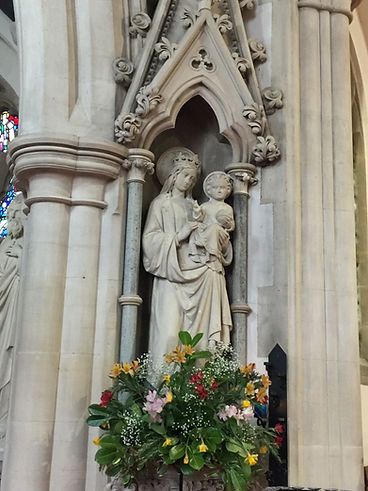St Mary's Catholic Church in East Hendred
.jpg)

St Mary's Church from 1904 postcards
The Catholic Emancipation Act of 1829 enabled Catholics to practise their faith and become full citizens of England.
Soon after the signing of the Act. Charles Eyston, the then squire of Hendred Estate, was made a Justice of the Peace and in 1831 he was appointed High Sheriff of Berkshire (East Hendred was part of Berkshire then).
When the news of the honour reached Hendred, Charles Eyston was out riding. On his return from the Downs he found the whole village assembled to cheer him home. He and his son Charles John were very touched by this great show of love and pride. One imagines they discussed it together and the idea of building a new church began to develop in their minds.
Throughout the Reformation, Catholics were not allowed to celebrate Mass, but many of the Recusant families continued to practise their faith at great personal risk. (‘Recusant’ comes from the Latin recusare, meaning to refuse, because the Catholics refused to attend Anglican church services). In the seventeenth century restrictions were relaxed and Mass was allowed, but only for family and retainers. Catholics were still not able to hold public office.
With the passing of the Emancipation Act, St Amand’s chapel at Hendred House became known as a Mass centre for all the neighbourhood – so much so that the library adjoining the chapel had to be used to accommodate the overflow.
Charles and his son continued to talk about the new church, but with his death in 1857 it was left to Charles John to carry out the actual building. In 1863 the foundation stone was laid and in 1865 St Mary’s was consecrated by Dr Thomas Grant, the Catholic Bishop of Southwark. At that time Hendred was a part of the Southwark diocese. Portsmouth diocese was not formed until 1882 under Southwark as metropolitan.
In the corbels below the roof you will see eight Coats of Arms. On the south side are those of A.C. Buckler, the architect, Thomas Luck the Rector (as the parish priest was then described in his memorial window in the north of the sanctuary), Bishop Thomas Grant, and Charles John Eyston, the founder (who also has a memorial brass of great interest on the west wall). On the north side there are the arms of the four families who have occupied Hendred House: de Turberville, Arches, Stowe and Eyston.
Canon Luck, who came as a supply priest to St Amand’s in 1862, stayed for fifty years and built the presbytery, which more recently has been used as a monastery. The high altar was given by Charles John Eyston and the rood screen with the figures of Jesus, Mary and John was given by Canon Luck’s father, Alfred, who after his wife died, was ordained priest and become a monk at Ramsgate.
The bridge from the presbytery to the church was built to give the priest easier access and to avoid his breaking the law – only in the twentieth century did it become legal for Catholics to wear clerical or religious dress in the street! The present bridge replaces the Victorian original.
Maureen Eyston, 2007
Revised 2019

